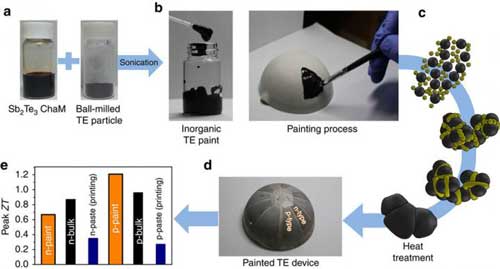| Posted: Dec 08, 2016 |
A thermoelectric material in paintable liquid form
(Nanowerk News) A new study, led by Professor Jae Sung Son of Materials Science and Engineering at UNIST has succeeded in developing a new technique that can be used to turn industrial waste heat into electricity for vehicles and other applications.
|
|
In their study, the team presented a new type of high-performance thermoelectric (TE) materials that possess liquid-like properties. These newly developed materials are both shape-engineerable and geometrically compatible in that they can be directly brush-painted on almost any surface.
|
 |
| This is a comparison of power generation between the conventional planar-structured TE generator and the painted TE generator on a curved heat source. (Image: UNIST)
|
|
Scientists hope that their findings, described in the prestigious journal Nature Communications ("High-performance shape-engineerable thermoelectric painting"), will pave the way to designing materials and devices that can be easily transferred to other applications.
|
|
The thermoelectric effect is the direct conversion of temperature differences to electric voltage and vice versa. This effect can be used either for heating or for cooling, such as in small cooling systems, automotive cooling systems, as well as waste heat recovery system for ships. In addition, the thermoelectric generator modules used in these devices are configured as rectangular parallelepipeds.
|
|
The output power of thermoelectric generators depends on device engineering minimizing heat loss, as well as inherent material properties. According to the research team, the currently existing liquid-like TE materials have been largely neglected due to the limited flat or angular shape of devices.
|
|
However, considering that the surface of most heat sources where these planar devices are attached is curved, a considerable amount of heat loss is inevitable. To address this issue, the research team presented the shape-engineerable thermoelectric painting technique where they they directly brush TE paints onto the surface of heat sources to produce electricity.
|
 |
| Schematics illustrate the fabrication of painted thermoelectric devices. (Image: UNIST) (click on image to enlarge)
|
|
Using this technique, one can now easily achive electricity via the application of TE paints on the exterior surfaces of buildings, roofs, and cars.
|
|
To show the feasibility of the currently proposed technology, they also fabricated TE generators through painting TE paints on flat, curved and large-sized hemispherical substrates, demonstrating that it is the most effective means of heat energy collection from any heat sources with exceedingly high output power density of 4.0 mW cm-2, which is the best value among the reported printed TE generators.
|
|
"By developing integral thermoelectric modules through painting process, we have overcome limitations of flat thermoelectric modules and are able to collect heat energy more efficiently." said Professor Son. "Thermoelectric generation systems can be developed as whatever types user want and cost from manufacturing systems can also be greatly reduced by conserving materials and simplifying processes.."
|
|
"Our thermoelectric material can be applied any heat source regardless of its shape, type and size." said Professor Son. "It will place itself as a new type of new and renewable energy generating system."
|


